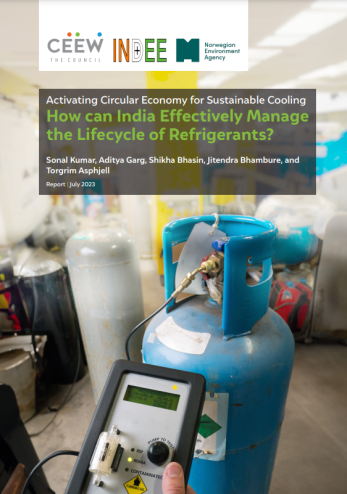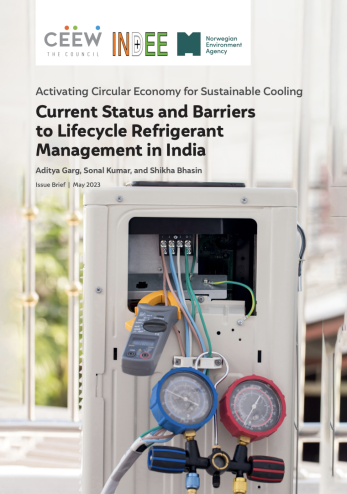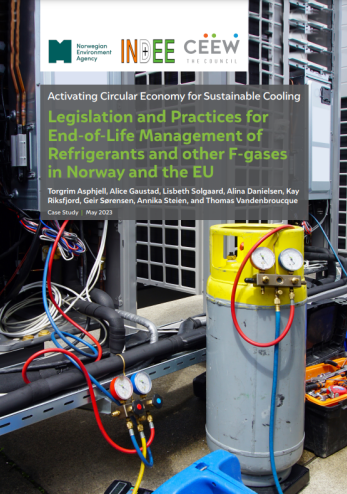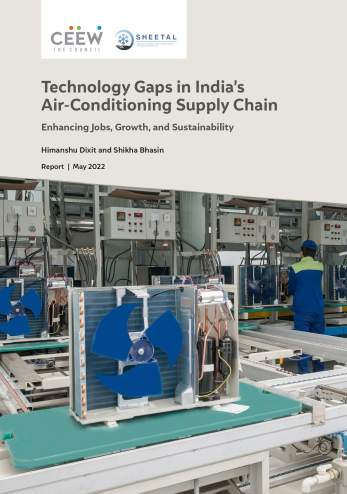



Suggested Citation: Dixit, Himanshu, Shikha Bhasin, Paras Bhattrai, Sunil Mani, and Arnab K. Laha. 2023. Perceptions of Refrigeration and Air-conditioning Service Technicians on India Cooling Action Plan: Enhancing Servicing Sector Jobs for a Just Transition. New Delhi: Council on Energy, Environment and Water.
The rising demand for air-conditioners in India will pose challenges from climate and energy consumption standpoints. The role of trained service technicians will be key in maintaining the rated efficiency and performance of units, as well as ensuring proper lifecycle refrigerant management.
This report tries to capture certain attributes of the room air-conditioner (RAC) servicing sector such as levels of training and awareness of technicians, income drivers and financial status, on-job challenges, as well as technicians’ aspirations and preferences on what should happen in order to revamp the informal RAC servicing sector in India.
It also attempts to understand how service technicians view the government’s existing aims, targets, and programmes pertaining to training and certification, HFC phase-down and skilling in the RAC servicing sector. The study assimilates these perceptions in the context of the prevailing training and certification programmes, to provide recommendations for the roll-out of more effective strategies.
Air-conditioning is one way to mitigate the effects of rising heat on human population, and is therefore rightly acknowledged as a developmental necessity under the India Cooling Action Plan (ICAP) (MoEFCC 2019). As India rapidly urbanises and grows in population, the need to enable access to cooling in hot temperatures will inevitably increase the prevalence of air-conditioning.
The rise in the access and use of air-conditioning will pose challenges from climate and energy consumption standpoints. First, the refrigerant technologies and fluorinated gases used presently in air-conditioning systems have high global warming potential (GWP). For instance, modelling assessments suggest that with about 10 per cent leakage rate, R410A alone will be responsible for about 16 per cent of total global warming by 2030 (Chaturvedi and Sharma 2015). Second, the energy requirements of a cooling system are substantial. Just the space cooling segment is responsible for about 12 per cent of total electricity use in the country (MoEFCC 2019). Simultaneous use of cooling units by a large number of people put the electricity grid under stress, which results in blackouts as well as high price of electricity to service that power demand. Hence, there is sizeable scope and opportunity to mitigate the primary (caused by refrigerants) and secondary (electricity use) emissions in the cooling sector, as well as make cooling more affordable to the larger populace.
In order to ensure that the cooling sector delivers the potential dividend in terms of climate change mitigation and energy efficiency, the fitness of cooling units during their operational lifecycle has to be maintained. Service technicians, therefore, assume a very important role as regular servicing is crucial to maintaining efficiency and performance. This is true right from the installation of air-conditioners to preventive servicing and maintenance at regular intervals.
The prevailing standards of servicing in India, particularly in the room air-conditioning segment, need substantial improvement, as also recognised and enshrined in the ICAP. Several aspects have been prioritised: training and upskilling of service technicians; access to toolkits; and fixing the supply and demand side of servicing to a) improve the quality of service and b) provide commensurate remuneration for technicians’ time. Deliberations on these plans have been ongoing since the publication of the ICAP. Certain recommended actions have also been implemented but a large-scale roll out hasn’t happened yet.
In this light, through a sample survey of service technicians the report tries to capture certain attributes of the sector such as levels of training and awareness of technicians, income drivers and financial status of technicians, challenges on the job, etc., as well as technicians’ aspirations and preferences in terms of what should happen in order to revamp the RAC informal sector in India. With this background, the report attempts to answer the following research questions:
The study adopts a mixed method research design. It’s based on a sample survey with 369 technicians, three focussed group discussions with service technicians, interviews and discussions with experts from OEMs and service providers, and desk research to capture information about the policies directed at the RAC servicing sector.
A majority of technicians laid emphasis on good training as well as to following the prescribed servicing practices.
On certification, an overwhelming majority of the surveyed service technicians showed an inclination to get a formal certificate approved by the GoI.
It is a strategy to provide sustainable cooling in India across different sectors including residential and commercial buildings, as well as cold chains in healthcare, agriculture, and commercial applications. Prepared by the Ministry of Environment, Forest, and Climate Change, it discusses how this sustainability potential of the cooling sector can be leveraged via research and development on green cooling technologies and training of service technicians. The ICAP also provides three concrete targets to be achieved by 2037-38, alongside short-, medium-, and long-term recommendations to meet them.
Servicing technicians are to an air conditioner, what a doctor is to us. A technician understands the anatomy of an AC and can check for any abnormal functionality that can damage the health of an AC. In addition to periodically and safely cleaning the unit for optimal efficiency, the technician also diagnoses and fixes any mechanical problems that can impair cooling. While we may go to a doctor only in the case of illness, it is common wisdom that preventive health check ups help diagnose problems early on. Similarly, preventive servicing once before the AC season starts and once after it ends i.e., pre- and post- summer cleaning is important.
1. Saves electricity. 2. Enhances and maintains the cooling performance of the unit. 3. Keeps the AC energy efficient (i.e. cools with less power). 4. Reduces frequent breakdowns. 5. Reduces refrigerant consumption during the working life of AC and thereby reduces direct and indirect emissions of greenhouse gases. ~15% energy saving by cleaning AC filter (Source: Energy.gov) ~50% reduction in AC performance is avoided (Source: UNEP)
Servicing your AC is more than just cleaning your AC. Here are seven steps to take care of our AC, so that it can take better care of us. 1. Request for a trained technician who carries calibrated tools, personal protection equipment (PPE), company ID card, and training certificate (where possible). 2. Ensure that the technician performs basic system checks, including the correct refrigerant gas to be used, its tonnage and voltage requirements, AC remote functions, and swinging of blowers, for a complete diagnosis. 3. Request the technician to check electrical connections, wires, and sensors to prevent energy loss, and chances of overheating. 4. Ensure that the technician cleans coils and filters for unhindered exchange of air. 5. Ensure leak detection, testing and leak arresting throughout the AC pipes. 6. After the leak is repaired, ensure that the refrigerant gas is recovered using refrigerant recovery equipment, and not released into the environment at the time of refilling. 7. Ensure that the system is flushed and evacuated before the refrigerant gas is refilled.

Activating Circular Economy for Sustainable Cooling

Activating Circular Economy for Sustainable Cooling

Activating Circular Economy for Sustainable Cooling

Activating Circular Economy for Sustainable Cooling

Technology Gaps in India’s Air-Conditioning Supply Chain